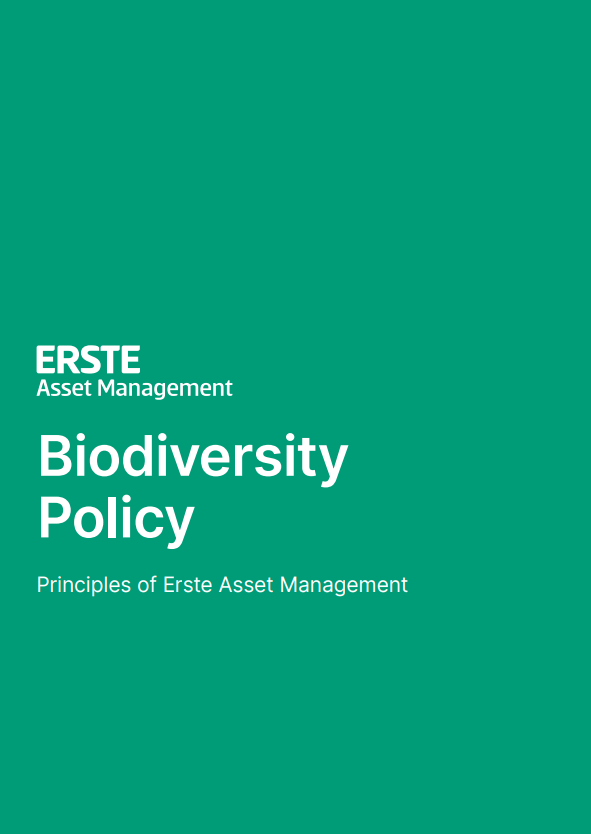The global biodiversity crisis is also called the “twin crisis” of the climate crisis, given that causes and effects are linked. Also, human economic activity underlies both crises. By the loss of biodiversity we mean that the services provided by ecosystem are impaired. The resulting burden on the resilience of the planet also poses a significant threat to the profitability and stability of financial systems.
According to the UNEP FI (United Nations Environment Programme Finance Initiative), 13 of the 18 sectors represented in the FTSE 100, with a market capitalisation of USD 1.6 trillion, run production processes that are highly or very highly dependent on nature. This illustrates that the global economy and financial portfolios are embedded in natural processes, which affects their performance.
The German Federal Agency for Nature Conservation (BfN), together with other partners, recommends that financial institutions “go beyond the regulatory” and change the way they think and act about biodiversity. This recommendation is based on scientific evidence and takes into account the 2030 and 2050 biodiversity targets agreed by elected decision-makers around the world.
In the financial sector, we are experiencing a shift where long-term profitability depends on greater biodiversity and associated functioning services of the ecosystems. While the loss of biodiversity is a risk for companies, investments for example in conservation measures also provide opportunities.
What does biodiversity mean, and how can it be measured?
Biodiversity or biological diversity can be understood as the variety of life and refers, quite simply, to the uniqueness of all living things (Federal Ministry for Climate Action, Environment, Energy, Mobility, Innovation & Technology). Ecosystems such as forests, meadows, water bodies, etc. are habitats with a high number of species that influence each other positively and determine the energy and nutrient cycle. Habitats with high biodiversity are generally more resilient vis-à-vis disturbances (natural or anthropogenic), and more productive as well. This can also be translated into economic terms: greater biodiversity enables better ecosystem services, which is directly necessary for economic activity.
The conversion of leachate into drinking water, for example, is, according to the Federal Environment Agency, one of the ecosystem services of the populated zones of the soil and the aquifers. A good ecological condition is a prerequisite for this. Glaciers, too, are sensitive ecosystems, because resident microorganisms carry out photosynthesis and store CO2. They also play an important part in the global carbon cycle and are not a “dead habitat, but an active ecosystem”, as ecologist Klemens Weisleitner describes, who studies processes and material flows in glaciers.
Even more specifically, biodiversity includes the biodiversity of ecosystems, of species, and genetic biodiversity. It can therefore also be measured in different ways (number of species, degree of ecosystem integrity, etc.). The Finance for Biodiversity Initiative compares different approaches:
- MSA (Mean Species Abundance) measures “intactness”. This key ratio compares the abundance of endemic species in ecosystems to their estimated abundance in the same ecosystem if it were still intact.
- PDF (Potentially Disappeared Fraction) measures the loss of species in 1m2 of land or 1m3 of water, in one year, in a given area, due to environmental impact.
Other approaches deal with the risk of species extinction or try to assign monetary values to ecosystem services (wood production, drinking water, carbon storage, recreational effect, etc.).
EU Nature Restauration Act passed with slim majority
How can we protect biodiversity? In addition to our commitment as part of the private financial sector to integrate biodiversity protection into our processes, the most direct measure is the installation of legal conservation zones. As a result of COP 15 (UN Biodiversity Conference) which took place in December 2022, it is up to the countries to agree on steps to implement the Global Biodiversity Framework (GBF). The GBF stipulates that biodiversity should be conserved and that sustainable use, as well as access to and equitable sharing of the benefits arising from the use of (genetic) resources, should be ensured. Various legal frameworks have been established since then.
The recently passed EU Nature Restauration Act was adopted by a narrow majority (336 MEPs voted in favour, 300 against) and calls for the renaturation of at least 20% of all land and marine areas in the EU by 2030; by 2050, all ecosystems in need of renaturation are to be restored. Implementation is left to the individual member states. According to a report by the European Environment Agency, about 80% of the habitats protected in the EU are in poor condition.
How do we integrate biodiversity, and what can we improve?
At Erste AM, we have been involved in sustainable investment for many years and have integrated biodiversity agendas into our analysis. We scrutinise the sustainable use of land and water resources by the companies in our portfolios and assign companies with operations close to sensitive and/or polluted ecosystems a corresponding risk. Any involvement in controversies regarding deforestation is taken into account negatively. Specifically affected are, for example, industries that are linked to relevant deforestation fronts or companies that are involved in the production of goods such as timber, beef or soy or use palm oil, which in turn could be associated with deforestation.
As a first step towards an even more targeted integration, we decided to support the “Declaration of the Private Financial Sector to the Conference of the Parties to the Convention on Biological Diversity”, established by the UNEP Finance Initiative (UNEP FI) and others, and signed by 154 financial institutions with more than 24.8 trillion in assets under management. Our commitment in this context includes a declaration in favour of “contributing to the protection and restoration of biodiversity and ecosystems through our financing activities and investments”.

On the basis of our recently published Biodiversity Policy, we also ensure that relevant agendas are formally integrated into our processes. The targets defined in the policy are to be achieved by 2030 and include the implementation of specific, more accurate data to identify companies that pose biodiversity risks, as well as engagement and voting to support the according improvements. Companies associated with global deforestation issues could be part of the focus list, as could be those with high biodiversity or water risks.
By supporting shareholder resolutions at AGMs and also through targeted engagements on these issues, we aim to support progress on the part of companies. When it comes to engagement, we also want to take an active role in the Nature Action 100 initiative, which identifies 100 biodiversity-relevant companies and initiates investor engagement in order to demand corporate action for the protection and restoration of nature.
Progress reports will be produced on the basis of key indicators to guarantee that improvements have indeed been made. As Erste AM, we have set ourselves a divestment deadline of two years in case of no progress on the part of the companies despite our engagement.
More information, insights and expert opinions on the topic of biodiversity can be found in our new ESGenius Letter.
For a glossary of technical terms, please visit this link: Fund Glossary | Erste Asset Management
Legal note:
Prognoses are no reliable indicator for future performance.
Legal disclaimer
This document is an advertisement. Unless indicated otherwise, source: Erste Asset Management GmbH. The language of communication of the sales offices is German and the languages of communication of the Management Company also include English.
The prospectus for UCITS funds (including any amendments) is prepared and published in accordance with the provisions of the InvFG 2011 as amended. Information for Investors pursuant to § 21 AIFMG is prepared for the alternative investment funds (AIF) administered by Erste Asset Management GmbH pursuant to the provisions of the AIFMG in conjunction with the InvFG 2011.
The currently valid versions of the prospectus, the Information for Investors pursuant to § 21 AIFMG, and the key information document can be found on the website www.erste-am.com under “Mandatory publications” and can be obtained free of charge by interested investors at the offices of the Management Company and at the offices of the depositary bank. The exact date of the most recent publication of the prospectus, the languages in which the fund prospectus or the Information for Investors pursuant to Art 21 AIFMG and the key information document are available, and any other locations where the documents can be obtained are indicated on the website www.erste-am.com. A summary of the investor rights is available in German and English on the website www.erste-am.com/investor-rights and can also be obtained from the Management Company.
The Management Company can decide to suspend the provisions it has taken for the sale of unit certificates in other countries in accordance with the regulatory requirements.
Note: You are about to purchase a product that may be difficult to understand. We recommend that you read the indicated fund documents before making an investment decision. In addition to the locations listed above, you can obtain these documents free of charge at the offices of the referring Sparkassen bank and the offices of Erste Bank der oesterreichischen Sparkassen AG. You can also access these documents electronically at www.erste-am.com.
Our analyses and conclusions are general in nature and do not take into account the individual characteristics of our investors in terms of earnings, taxation, experience and knowledge, investment objective, financial position, capacity for loss, and risk tolerance. Past performance is not a reliable indicator of the future performance of a fund.
Please note: Investments in securities entail risks in addition to the opportunities presented here. The value of units and their earnings can rise and fall. Changes in exchange rates can also have a positive or negative effect on the value of an investment. For this reason, you may receive less than your originally invested amount when you redeem your units. Persons who are interested in purchasing units in investment funds are advised to read the current fund prospectus(es) and the Information for Investors pursuant to § 21 AIFMG, especially the risk notices they contain, before making an investment decision. If the fund currency is different than the investor’s home currency, changes in the relevant exchange rate can positively or negatively influence the value of the investment and the amount of the costs associated with the fund in the home currency.
We are not permitted to directly or indirectly offer, sell, transfer, or deliver this financial product to natural or legal persons whose place of residence or domicile is located in a country where this is legally prohibited. In this case, we may not provide any product information, either.
Please consult the corresponding information in the fund prospectus and the Information for Investors pursuant to § 21 AIFMG for restrictions on the sale of the fund to American or Russian citizens.
It is expressly noted that this communication does not provide any investment recommendations, but only expresses our current market assessment. Thus, this communication is not a substitute for investment advice.
This document does not represent a sales activity of the Management Company and therefore may not be construed as an offer for the purchase or sale of financial or investment instruments.
Erste Asset Management GmbH is affiliated with the Erste Bank and austrian Sparkassen banks.
Please also read the “Information about us and our securities services” published by your bank.


